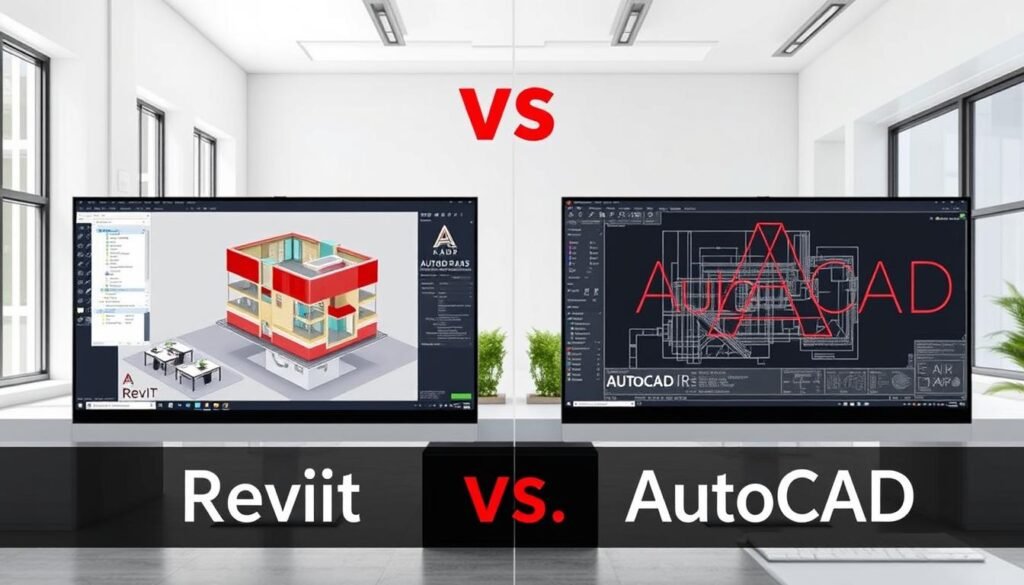Building Information Modeling (BIM) software has revolutionized the architecture, engineering, and construction (AEC) industry. Revit software for architects has become an essential tool, offering a range of features that improve design, collaboration, and project delivery.
By leveraging Revit’s advanced capabilities, architectural firms can streamline their workflows, reduce errors, and enhance collaboration among stakeholders. This leads to significant time and cost savings, ultimately improving the bottom line.
The benefits of using Revit for architectural firms are multifaceted, including improved productivity and enhanced collaboration. As the AEC industry continues to evolve, adopting Revit can help firms stay competitive.
Key Takeaways
- Revit improves productivity for architectural firms.
- Revit reduces errors and enhances collaboration.
- Adopting Revit can lead to significant cost savings.
- Revit helps firms stay competitive in the AEC industry.
- Revit’s advanced features support improved project delivery.
The Evolving Challenges in Modern Architectural Practice
Modern architectural practice is confronted with evolving challenges that impact productivity and efficiency. The industry is under increasing pressure to deliver projects quickly and effectively, while maintaining high standards of quality.
Traditional Workflow Bottlenecks
Traditional workflow bottlenecks, such as manual drafting and data duplication, continue to hinder architectural firms. These inefficiencies lead to errors, delays, and increased costs, ultimately affecting a firm’s bottom line and competitiveness. Implementing best revit practices for firms can help alleviate these issues.
Rising Client Expectations and Competition
Rising client expectations and intensifying competition further exacerbate the challenges faced by architectural firms. To stay ahead, firms must adopt strategies that enhance revit productivity and improving revit efficiency. A comparison of traditional methods versus Revit implementation is shown below:
| Aspect | Traditional Methods | Revit Implementation |
|---|---|---|
| Design Process | Manual drafting, prone to errors | Automated drafting, reduced errors |
| Data Management | Data duplication, inconsistent updates | Single-source data, synchronized updates |
| Collaboration | Limited collaboration tools | Enhanced team collaboration |
By adopting Revit, architectural firms can overcome traditional workflow bottlenecks and improve their overall productivity and competitiveness.

Revit for Architectural Firms: A Comprehensive BIM Solution
Revit has revolutionized the architectural industry by providing a comprehensive BIM solution for firms. This powerful tool has transformed the way architects design, collaborate, and deliver projects. By leveraging Revit’s capabilities, architectural firms can improve their productivity, reduce errors, and enhance collaboration.
Core Capabilities That Transform Design Processes
Revit offers a range of core capabilities that transform design processes, including parametric modeling and data-rich modeling. These features enable architects to create complex designs with precision and accuracy. The software also allows for the creation of detailed building models that can be used throughout the project lifecycle.
- Parametric modeling enables the creation of intelligent building components that can be modified easily.
- Data-rich modeling allows for the integration of various data types into the building model.
The Strategic Shift from CAD to BIM-Centered Workflows
The shift from traditional CAD to BIM-centered workflows is a strategic move for architectural firms. Revit facilitates this transition by providing a platform that integrates various aspects of building design and construction. By adopting BIM workflows, firms can improve collaboration, reduce errors, and enhance project delivery.
| Feature | CAD | BIM (Revit) |
|---|---|---|
| Modeling Approach | 2D/3D modeling | Intelligent 3D modeling |
| Data Integration | Limited data integration | Comprehensive data integration |
| Collaboration | Limited collaboration features | Advanced collaboration tools |

By adopting Revit and shifting to BIM-centered workflows, architectural firms can stay competitive in the industry and deliver high-quality projects efficiently.
Time-Saving Benefits That Boost Productivity
Revit’s comprehensive BIM solution offers architectural firms a multitude of time-saving benefits that significantly boost productivity. By streamlining various aspects of the design and documentation process, Revit enables architects to focus on high-value tasks.
Streamlined Design Documentation and Drawing Generation
Revit’s ability to automatically generate drawings and documentation from the BIM model reduces the time spent on these tasks by up to 50%. This automation not only speeds up the process but also minimizes the likelihood of human error.
Automated Updates Across All Project Views
One of Revit’s most significant advantages is its ability to automatically update all project views whenever a change is made to the model. This ensures that all stakeholders have access to the most current information.
Simultaneous Floor Plan and Elevation Updates
With Revit, changes made to the floor plan are automatically reflected in the elevation views, and vice versa. This synchronization eliminates the need for manual updates, saving time and reducing errors.
Automatic Schedule Generation and Updating
Revit can automatically generate schedules for various elements within the project, such as doors, windows, and materials. These schedules are dynamically linked to the model, ensuring that they remain up-to-date as the project evolves.
Enhanced Team Collaboration and Communication
Revit facilitates improved collaboration among project stakeholders by providing a shared platform for design and documentation. This enables teams to work together more effectively, reducing misunderstandings and miscommunications.
- Improved data sharing and coordination
- Enhanced visibility into project changes
- Better communication among stakeholders
Cost Reduction Strategies Through Revit Implementation
Architectural firms can achieve considerable cost reductions by implementing Revit, thanks to its advanced features for error detection and material quantification. By leveraging Revit’s Building Information Modeling (BIM) capabilities, firms can streamline their design and construction processes, minimizing waste and optimizing resource allocation.
Early Error Detection and Clash Prevention
One of the significant advantages of using Revit is its ability to detect errors and clashes early in the design phase. This feature allows architects to identify and rectify potential issues before they become costly problems during construction. By doing so, firms can avoid expensive rework and reduce the likelihood of project delays.
Accurate Material Quantification and Cost Estimation
Revit enables accurate material quantification and cost estimation, allowing firms to better manage project costs. With Revit’s quantification tools, architects can automatically generate detailed material takeoffs, reducing the risk of human error and enabling more precise cost forecasting. This capability helps firms to stay within budget and make informed decisions about material procurement.
Optimized Staffing and Resource Allocation
By implementing Revit, architectural firms can optimize their staffing and resource allocation. Revit’s automated processes and streamlined workflows enable staff to focus on high-value tasks, reducing the need for manual data entry and minimizing the risk of errors. This optimization leads to more efficient use of resources, resulting in cost savings and improved project outcomes.
| Cost Reduction Strategy | Revit Feature | Benefit |
|---|---|---|
| Early Error Detection | Clash Detection | Avoids costly rework |
| Accurate Cost Estimation | Material Quantification | Precise cost forecasting |
| Optimized Resource Allocation | Automated Processes | Efficient use of staff and resources |
By adopting Revit and leveraging its advanced features, architectural firms can achieve significant cost reductions and improve their overall competitiveness in the market.
Maximizing Revit ROI Through Strategic Implementation
To maximize Revit ROI, architectural firms must adopt a strategic implementation approach that aligns with their specific business needs and goals. This involves a multi-faceted strategy that encompasses phased adoption, comprehensive staff training, and the development of custom templates and component libraries.
Developing a Phased Adoption Plan
A phased adoption plan allows firms to gradually integrate Revit into their workflow, minimizing disruption and ensuring a smooth transition. This approach enables firms to pilot the software on smaller projects before scaling up to larger, more complex initiatives.
Investing in Comprehensive Staff Training
Comprehensive staff training is crucial for maximizing Revit ROI. Firms should invest in role-specific training programs that cater to the diverse needs of their staff members.
Role-Specific Training Programs
Role-specific training ensures that each team member is equipped with the necessary skills to leverage Revit’s capabilities effectively. For instance, architects can benefit from training focused on design and modeling, while engineers can focus on analytical and simulation tools.
Continuous Learning Strategies
Continuous learning strategies, such as workshops, webinars, and online courses, help staff stay updated with the latest Revit features and best practices. This ongoing education is vital for maintaining a competitive edge and maximizing ROI.
Building Custom Templates and Component Libraries
Developing custom templates and component libraries streamlines the design process, enhances productivity, and ensures consistency across projects. By creating tailored resources, firms can reduce the time spent on repetitive tasks and improve overall efficiency.
Here is an example of how firms can benefit from custom templates and component libraries:
| Benefits | Description | Impact |
|---|---|---|
| Streamlined Design Process | Custom templates simplify the design process by providing pre-configured settings and standards. | Reduced project timelines |
| Enhanced Productivity | Component libraries enable quick access to frequently used elements, reducing repetitive work. | Increased staff efficiency |
| Consistency Across Projects | Standardized templates and components ensure a uniform look and feel across all projects. | Improved brand identity |
Real-World Success Stories: Transforming Practice with Revit
By implementing Revit, architectural firms can significantly reduce project timelines and costs while improving overall quality. This transformation is evident in various success stories across the industry.
Small Firm Case Study: Competing with Larger Practices
A small architectural firm with a team of 15 people adopted Revit to enhance their BIM capabilities. By leveraging Revit’s automated documentation and clash detection features, they were able to reduce project delivery times by 30% and improve their competitiveness against larger firms.
| Firm Size | Revit Implementation Benefits | Project Outcome |
|---|---|---|
| Small (15 people) | Automated documentation, clash detection | 30% reduction in project delivery time |
| Large (500 people) | Standardized workflows, improved collaboration | 25% reduction in project costs |
Large Practice Case Study: Standardization Across Multiple Offices
A large architectural practice with multiple offices implemented Revit to standardize their workflows and improve collaboration across teams. By creating custom templates and component libraries, they achieved a 25% reduction in project costs due to reduced errors and improved efficiency.
The success stories of these firms demonstrate the potential of Revit to transform architectural practices, regardless of their size. By adopting Revit, firms can achieve significant benefits in terms of time, cost, and quality.
Overcoming Implementation Challenges and Resistance
As architectural firms embark on implementing Revit, they must navigate various hurdles. The transition to Revit can be complex, involving not just a new software tool, but a fundamental shift in workflow and methodology.
Managing the Learning Curve and Productivity Dip
A significant challenge firms face is managing the learning curve associated with Revit. Comprehensive training programs are essential to help staff become proficient in using the software, thereby minimizing the productivity dip that often accompanies new technology adoption.
Hardware and Infrastructure Requirements
Ensuring that the firm’s hardware and infrastructure are adequate to support Revit is crucial. This includes having sufficient processing power, memory, and storage to handle the demands of BIM projects.
Addressing Staff Resistance to Change
Staff resistance to adopting new technology is a common issue. To overcome this, firms should implement a change management strategy that includes clear communication, training, and support. Encouraging feedback and involving staff in the implementation process can also help alleviate concerns.
| Challenge | Strategy | Benefit |
|---|---|---|
| Managing Learning Curve | Comprehensive Training | Reduced Productivity Dip |
| Hardware and Infrastructure | Upgrade and Optimize | Smooth Revit Operation |
| Staff Resistance | Change Management | Increased Adoption Rate |
Conclusion: Embracing Revit as a Competitive Advantage
Architectural firms that adopt Revit can experience significant benefits, including improved productivity and reduced costs. By leveraging Revit’s capabilities, firms can gain a competitive advantage in the industry. Revit for architectural firms offers a comprehensive BIM solution that streamlines design processes, enhances collaboration, and improves project outcomes.
The strategic implementation of Revit enables firms to stay ahead of the competition and achieve long-term success. By developing a phased adoption plan, investing in comprehensive staff training, and building custom templates and component libraries, firms can maximize Revit’s ROI. As a result, firms can improve their overall efficiency, reduce errors, and deliver high-quality projects.
Embracing Revit as a competitive advantage requires a deep understanding of its capabilities and best practices. By doing so, architectural firms can reap the revit benefits for architecture firms, including enhanced collaboration, improved productivity, and reduced costs. With Revit, firms can position themselves for success in a competitive market, driving business growth and profitability.

